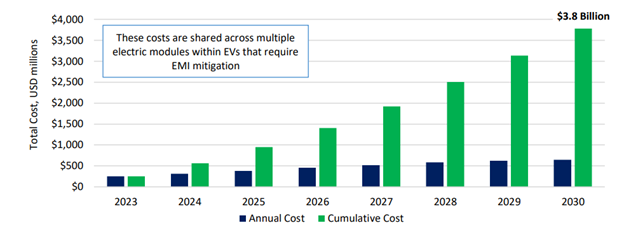NEW Center for Automotive Research report: Analog AM Band Interference in Electric Vehicles
Key point: $3.8 billion over the next seven years to reduce (not eliminate) the electromagnetic interference that disturbs AM radio reception in electric vehicles.
By John Bozzella
Congress is still toying with legislation to REQUIRE analog AM radio in all new vehicles.
That’s new territory for Washington.
Requirements for air bags, brakes, side impact protection, seat belts and other life-saving vehicle safety systems? Yes.
But forcing automakers to install analog AM radio tuners in all new vehicles – including electric vehicles? The government has never gone there before.
Unusual, but also unnecessary since consumers have access to lots of (and let’s face it, superior) options: digital AM and FM, internet-based radio, streaming and satellite services.
It’s no secret, some automakers have discontinued (or plan to discontinue) AM radio in certain vehicles.
Why? There’s research to indicate drivers barely listen to analog AM radio while driving. Plus, automakers have finite real estate behind the dashboard to house the newer technologies customers prefer.
There’s another reason, and it’s the subject of a new report from the Center for Automotive Research that examines analog AM radio and EVs. They just don’t mix.
Technically speaking: the high-voltage electrical systems and onboard electronics in EVs generate electromagnetic interference (EMI) that “distorts AM radio signals, affecting the listening experience for drivers and passengers.”
In other words, EMI makes the already fuzzy analog AM radio frequency basically unlistenable.
Fix it… the policymakers behind the AM for Every Vehicle Act say.
So the report looks at that.
There are techniques and equipment to help reduce AM radio interference in EVs. Reduce, not eliminate… that’s not possible for analog AM radio according to the report.

Shielding cables, interference filters, active noise cancellation, physical placement of components and vehicle redesigns are among the options.
This adds weight to a vehicle and reduces battery range.
But it also comes at a cost to customers.
The price tag? $3.8 billion in the next seven years to reduce interference just to keep analog AM radio buzzing in EVs.

By the way, the require-AM camp counters that keeping analog AM in the vehicle is necessary for public safety and to transmit emergency alerts (if you’re in the vehicle during an emergency, which happens).
But do you remember that nationwide emergency alert test from FEMA in October? I got it on my phone, and I’m not alone.
According to a survey from the Consumer Technology Association: 95 percent of adults received the alert on a phone, 15 percent on TV, five percent on FM radio and one percent via AM radio (that’s one percent total… not one percent in their vehicle).
Government forcing AM radio in vehicles:
Not required for public safety… not popular with consumers…
And now we know: not cheap.
John Bozzella is president and CEO of Alliance for Automotive Innovation.
###
Read more:
What’s All This Static About AM Radio and Cars?
June 5, 2023

